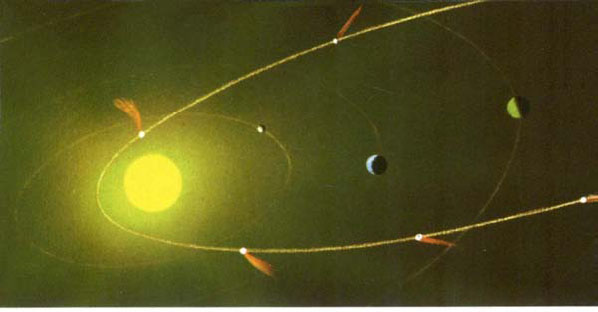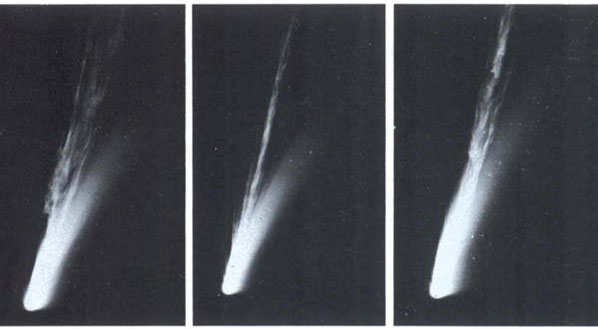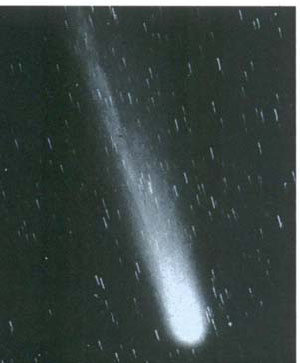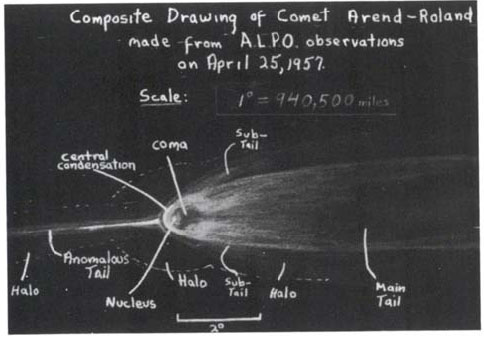
Comet’s path through solar system: The orbit of a comet is a long loop. The comet’s tail generally points away from the Sun. The nearer the comet is to the Sun, the more the tail trails out across the heavens.
The most mysterious members of the solar system are the comets. They are not regular visitors in the night sky, like planets; but they do visit us frequently—as many as five or more in a year. They usually appear suddenly, stay in view for a few weeks, then disappear. Some return after a period of years, but most do not.

Comet’s path through solar system: The orbit of a comet is a long loop. The comet’s tail generally points away from the Sun. The nearer the comet is to the Sun, the more the tail trails out across the heavens.
The first person to report a new comet is honored by having his name given to it. No wonder amateurs spend so much time seeking these elusive objects!
One of the most striking comets of many years was the eighth comet discovered in 1956. The discoverers were Arend and Roland. This was one of the few comets to exhibit a tail both fore and aft. It became so bright that it could be seen with the unaided eye despite city lights, challenging everyone to look at it. But very few comets become bright enough to be seen without binoculars or a telescope.
Comets are apparently planet-sized members of our solar system, but of uncertain origin. They shine by reflecting sunlight, as planets do; and they glow as sunlight ionizes gases in them. Besides gases, they contain enormous concentrations of larger particles, perhaps meteoritic material. Some comets have no tail at all, but in others it is spectacular in form and length. The tail appears to be made of material thrown off from the head.
POINTERS FOR OBSERVERS Comets may appear in any part of the sky at any time of year. Many an observer searches for comets every clear night. By scanning a different zone each evening, he can cover much of the sky during a week. Looking for new comets or for the return of old ones is good sport.
Many observing groups divide up the patrol work. Binoculars can be used, but a 3- to 6-inch telescope is better. Use low power for a wide field.
Once a comet is found, a camera attached to the telescope will be useful. Because film can store up light, much more of a comet can be seen on a photograph than through the telescope. For long exposure, follow the comet (here). Since comets change positions against the background of stars, stars in the photograph will trail.

Comet Mrkos: This new comet appeared in 1957. The series of photos was made over a span of several days. (Mt. Wilson and Palomar Obs.)
A comet can be superb in a small telescope. Usually it is a faint, glowing object with a hazy tail so thin that stars shine through it undimmed. In the head the concentrated part is the nucleus; the hazy material around it, the coma. The nucleus may be 100 to 50,000 miles in diameter; the head, 30,000 to over 1,000,000 miles across. The tail, if any, may spread widely and stretch out 100 million miles. It usually points away from the Sun, because of pressure of light and the solar wind. Tails change in appearance daily; changes can be sketched or photographed.
PERIODIC COMETS Some comets travel in elliptical orbits and, after a period of time, return again. (Most comets do not.) Most famous of the “repeaters” is Halley’s comet, observed closely in 1682 by Edmund Halley, the English astronomer. He discovered that its orbit was elliptical and predicted it would return in 1758 (it did). It was seen many times before Halley’s day, perhaps as early as 239 B.C. Its appearance in A.D. 1066 is depicted in the famous Bayeux tapestry, which chronicles the Norman conquest of England by William the Conqueror.

Halley’s Comet, May 29, 1910: Its many regular appearances have made it the best known of all comets. (Yerkes Obs.)
| Dare | Nome | Discovered |
| 1985 (Sep) | Giacobini-Zinner | 1900 |
| 1986 (Jan) | Boethin | 1975 |
| 1986 (Mar) | Holley | -239 |
| 1987 (Aug) | Encke | 1786 |
| 1987 (Dec) | Borrelly | 1904 |
| 1988 (Sep) | Temple 2 | 1873 |
| 1989 (Sep) | Brorsen-Metcolf | 1847 |
| 1989 (Nov) | Lovas | 1980 |
| 1990 (May) | Schwossmartn-Wachmann 3 | 1930 |
| 1990 (Sep) | Honda-Mrkos-Pajdusokova | 1948 |
| 1990 (Oct) | Encke | 1786 |
| 1990 (Dec) | Kearns-Kwee | 1963 |
| 1991 (Nov) | Faye | 1843 |
(Courtesy Brian Marsden)
Comets may be bright during one visit, faint the next, and after many visits may vanish for good, perhaps disintegrating to become meteor showers. Since a return cannot be accurately predicted, start hunting a month in advance. Consult almanacs and handbooks (here).
THINGS TO DO (1) Observe a zone for comets regularly. (2) Check lists of recurring comets and watch for them. (3) Plot the course of a comet on your atlas. (4) Try to predict the daily positions of a comet. (5) Make drawings or photographs of changes in appearance.

Comet anatomy: A sketch made during observations by the Comet Recorder of Association of Lunar and Planetary Observers. (David Meisel)